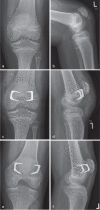Anterior distal femoral hemiepiphysiodesis can reduce fixed flexion deformity of the knee: a retrospective study of 83 knees
- PMID: 29902104
- PMCID: PMC6202731
- DOI: 10.1080/17453674.2018.1485418
Anterior distal femoral hemiepiphysiodesis can reduce fixed flexion deformity of the knee: a retrospective study of 83 knees
Abstract
Background and purpose - Fixed knee flexion deformity in children is a common problem in various diseases including myelomeningocele and cerebral palsy. Until now, only a few studies focusing on the surgical procedure of anterior distal femoral hemiepiphysiodesis have been published. We analyzed outcome and correction rate in the largest case series to date of patients treated by staples or 8-plates. Patients and methods - We reviewed the medical records of all patients with fixed knee flexion deformity who were treated with anterior distal femoral hemiepiphysiodesis using either staples or 8-plates between the years 2002 and 2017 (73 patients; 130 knees). 49 patients (83 knees) had completed treatment with implant removal at the time of full correction of the deformity or at skeletal maturity and were included. The average age at operation was 12 years (6-20). Patients were assigned to 3 different groups based on their diagnosis: cerebral palsy, myelomeningocele, and the "other" group.d Results - Mean fixed knee flexion deformity improved from 21° (10-60°) to 8° (0-50°) (p < 0.001) with an average correction rate of 0.44° per month (range -2.14° to 1.74°). The correction rate per month was lowest for patients with cerebral palsy (0.20°), followed by the myelomeningocele group (0.50°), and the "other" group (0.58°). Implant loosening occurred in 10% of the treated knees with consecutive re-implantation in 5% of the cases. Interpretation - Anterior distal femoral hemiepiphysiodesis is an effective and safe method for the treatment of fixed knee flexion deformity in children. The optimal timing depends on the remaining individual growth potential, the underlying disease, and the extent of the deformity.
Figures


Similar articles
-
Guided growth for fixed knee flexion deformity.J Pediatr Orthop. 2008 Sep;28(6):626-31. doi: 10.1097/BPO.0b013e318183d573. J Pediatr Orthop. 2008. PMID: 18724198
-
Treatment of fixed knee flexion deformity by anterior distal femoral stapling.Knee Surg Sports Traumatol Arthrosc. 2012 Dec;20(12):2413-8. doi: 10.1007/s00167-012-1915-8. Epub 2012 Feb 4. Knee Surg Sports Traumatol Arthrosc. 2012. PMID: 22307752
-
Anterior distal femoral stapling for correcting knee flexion contracture in children with arthrogryposis--preliminary results.J Pediatr Orthop. 2010 Mar;30(2):169-73. doi: 10.1097/BPO.0b013e3181d07593. J Pediatr Orthop. 2010. PMID: 20179565
-
Distal Femur Anterior Hemiepiphysiodesis for Fixed Knee Flexion Deformity in Neuromuscular Patients: A Systematic Review.JBJS Rev. 2023 Jun 5;11(6). doi: 10.2106/JBJS.RVW.23.00001. eCollection 2023 Jun 1. JBJS Rev. 2023. PMID: 37276266
-
Temporary hemiepiphysiodesis using eight-plates for angular deformities of the lower extremities in children with X-linked hypophosphataemic rickets.Int Orthop. 2023 Mar;47(3):763-771. doi: 10.1007/s00264-023-05688-y. Epub 2023 Jan 16. Int Orthop. 2023. PMID: 36646902 Review.
Cited by
-
[Epiphysiodesis and hemiepiphysiodesis : Physeal arrest and guided growth for the lower extremity].Orthopade. 2022 May;51(5):415-432. doi: 10.1007/s00132-022-04219-8. Epub 2022 Mar 31. Orthopade. 2022. PMID: 35357554 Free PMC article. German.
-
Hemiepiphysiodesis for coronal angular knee deformities: tension-band plate versus percutaneous transphyseal screw.Arch Orthop Trauma Surg. 2022 Jan;142(1):105-113. doi: 10.1007/s00402-020-03602-4. Epub 2020 Sep 21. Arch Orthop Trauma Surg. 2022. PMID: 32959086
-
Mechanics of guided growth of the distal femur for correction of fixed knee flexion deformities: an extra-articular technique.Arch Orthop Trauma Surg. 2022 Nov;142(11):3027-3034. doi: 10.1007/s00402-021-03911-2. Epub 2021 Apr 21. Arch Orthop Trauma Surg. 2022. PMID: 33881593
-
How to avoid genu recurvatum in leg-length discrepancy treated with tension-band plates. A volumetric magnetic resonance analysis.J Orthop. 2024 Jun 8;57:35-39. doi: 10.1016/j.jor.2024.06.004. eCollection 2024 Nov. J Orthop. 2024. PMID: 38957798
-
Effective time, correction speed and termination time of hemi-epiphysiodesis in children.World J Orthop. 2024 Jan 18;15(1):1-10. doi: 10.5312/wjo.v15.i1.1. eCollection 2024 Jan 18. World J Orthop. 2024. PMID: 38293262 Free PMC article. Review.
References
-
- Beals R K. Treatment of knee contracture in cerebral palsy by hamstring lengthening, posterior capsulotomy, and quadriceps mechanism shortening. Dev Med Child Neurol 2001; 43: 802–5. - PubMed
-
- Blount W P, Clarke G R. Control of bone growth by epiphyseal stapling; a preliminary report. J Bone Joint Surg Am 1949; 31A: 464–78. - PubMed
MeSH terms
LinkOut - more resources
Full Text Sources
Other Literature Sources
Medical
